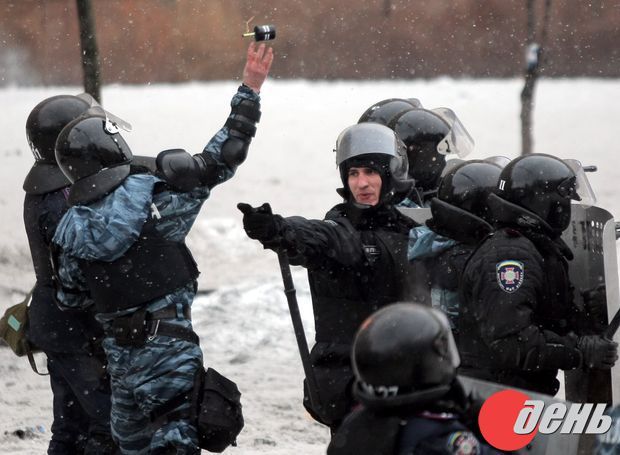A speedy and peaceful resolution of the difficult situation now prevailing in this country, in particular through objective information and not escalating the crisis, is largely dependent today on journalists’ professionalism and correct behavior. It should be said that most media workers have proved to be up to the task on seeing a hot spot emerging in their own country for the first time. In particular, they have been informing citizens virtually non-stop, often risking their personal health in the process. However, as photographers and camerapeople who are doing their job under fire admit, health risks are not the top of their concerns. “We work between the two warring camps,” The Day’s photographer Mykola Tymchenko noted, “and we get hit by both. It hurts me to think that Ukrainians stand on both sides of the barricades.” How have the Hrushevskoho Street clashes been seen by Ukrainian journalists through the lenses of their cameras?

Photo by Artem SLIPACHUK, The Day
Ruslan KANIUKA, The Day’s photo editor and photographer:
“Never before have I worked under such conditions. Light and noise grenades explode and stones fly from both sides over my head, while shots add to the mayhem. Journalists stand in the middle of it all, directly in the firing line. It feels scary at first, but then one gets used to danger and is just trying to do one’s job.”

Photo by Artem SLIPACHUK, The Day
Andrii TSAPLIIENKO, Inter TV channel’s journalist:
“There are two major difficulties when covering clashes in Hrushevskoho Street. Firstly, it is hard to avoid bias when you are in the midst of aggression. Secondly, it is difficult to work when people around you try to hit you in the head with a bullet, even if a rubber one. In general, never before have I thought that I would have to film such clashes in Ukraine and see so many fellow journalists wounded. I hope that the word ‘war,’ now used allegorically by the government and the opposition, will not move from political appeals into our stories. When staying amid bloody wars abroad, where people died right in front of my cameraperson Vadym Revun’s camera, I always wished at heart – yes, I know it was trite – continued peace and tranquility for my country.”

Photo by Artem SLIPACHUK, The Day
Mykola TYMCHENKO, The Day’s photographer:
“The situation in Hrushevskoho Street is terrible. One has to remember it when grenades are exploding and bullets flying overhead. But it is not as depressing as it is often pictured on TV. There is no need to further escalate the situation. All camerapeople and photographers catch themselves thinking several times per hour, whether to go behind the protesters and make an exclusive shot, or refrain from it and cut risk of being hit by a bullet. Most attempt to strike a balance between common sense and professional tenacity. The job is especially difficult, since we know that our compatriots are on both sides of the divide.”
Maksym LEVIN, lb.ua’s photographer:
“Euromaidan – it is when on your leaving home again, wife and kids tell you: ‘Honey, we were pleased to see you.’”
Ivan LIUBYSH-KIRDEI, 2+2 TV channel’s cameraperson and The Day’s contributor:
“I had my camera broken in Hrushevskoho Street, as someone scored a direct hit with cobblestone on me. Luckily, I was not injured, but the camera is out of service for good. I will keep it as a reminder of these extreme events in my country’s history, may they end as soon as possible. I grieved less over the broken equipment and more over the fact that I had been ‘disarmed’ at such an important moment and could not record everything that happened, while events in Hrushevskoho Street, as well as in Ukraine as a whole, were literally developing by minute.”







